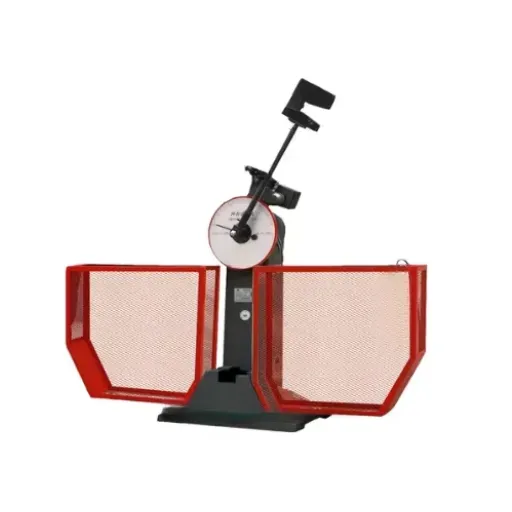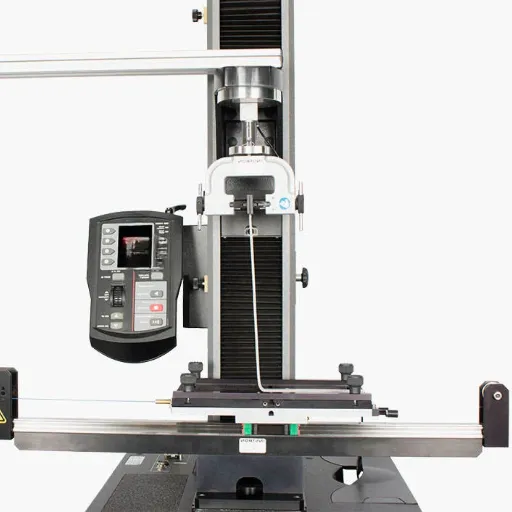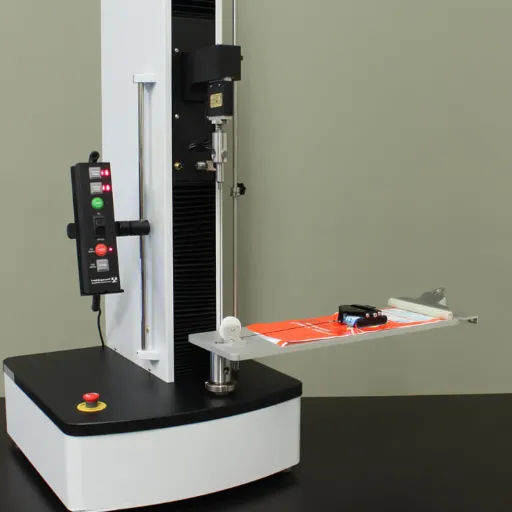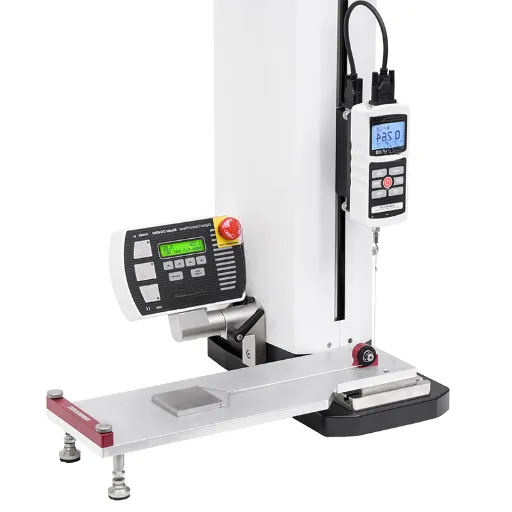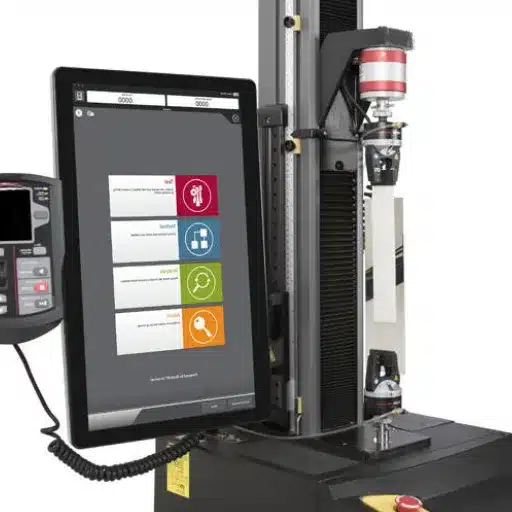In the context of research and industrial materials testing, timeliness and accuracy are crucial. An Impact Test Machine, also known as an impact tester, is specialized testing equipment that evaluates the strength and toughness of materials to sudden force or impact. In this article, I intend to discuss the special features and capabilities of the testing equipment and the advantages it offers. If you are an engineer, quality control specialist, or researcher, the insights offered regarding the workings of the impact test machine and its features can improve your testing methods and guarantee quality results each time. I encourage you to continue as I explain the advantages this equipment offers materials testing.
Introduction to Semi-Automatic Impact Testing Machines

What is a Semi-Automatic Impact Testing Machine?
The semi-automatic impact testing machine is used in material testing especially for testing the ability of a material to resist sudden forces or impacts. The machine specifically tests for the materials’ toughness and brittleness. Such data is paramount in the development of materials; as well as quality and safety control.
Testing semi-automatically means that the part of the pendulum or sample positioning is automated while some parts are done manually. Such operation cuts down the time taken for repeated tests and streamlines testing. Testing can be repeated numerous times without lowering the accuracy of the test. This type of testing is the middle ground between full and manual automation, which is suitable for many laboratories.
Such machines are utilized in industries such as aerospace, manufacturing, and construction, where it is fundamental to know the impact behavior of a material. The semi-automatic impact testing machines provide test results which can be trusted time and again, helping guarantee compliance of materials to safety and performance norms. This, in turn, aids in the creation of products that are of high quality and are durable.
Importance of Impact Testing in Quality Control
Impact testing is crucial in quality control as it helps ascertain how tough a material is along with how well it holds up against sudden forces or shocks. It ensures, through real-world simulations, that a material can actually hold up against stresses it will face during use. Impact tests also help manufacturers catch issues with materials well before they become part of a finished product and fail.
In addition, impact testing helps confirm that the materials used meet all safety and performance requirements. Such compliance is important for following regulations and helps to preserve consumer confidence and satisfaction. Impact testing as part of a systematic quality control procedure helps to ensure that risks are kept to a minimum, liabilities and warranties are kept in check, and the product remains useful for the intended application.
Moreover, the impact test assists in the integration of quality control and testing procedures, improving the company’s workflow and spurring innovation. Getting a comprehensive view of the impact test for materials gives the manufacturer the option to choose or create the appropriate materials for a particular use. With the reliability of the product improved, the impact test supports the evolution of design and manufacturing controls, elevating standards for quality and performance across other industries as well.
Overview of the Charpy Impact Test
The Charpy Impact Test, is a defined procedure that helps in determining a material’s toughness by calculating the energy absorbed during fracture. The test, which is performed on a notched specimen, consists of breaking the specimen with a pendulum hammer and calculating the energy absorbed to break the specimen using the pendulum. The joules measured are indicative of the material’s impact resistance and its behaviour facing sudden loading.
Such a test is crucial for assessing impact resistance materials, for instance, in construction, in transportation, and in manufacturing. Impact test results provide a clear picture of how the material will perform under stress, for example, at different temperatures. With varying temperatures, the materials may show different modes of failure; brittle or ductile, which is crucial for the right material selection for extreme temperatures.
Ultimately, the Charpy Impact Test brings understanding to the properties of materials and thus improves the safety and dependability of structures and products. It enables the industries to pick or design the right materials that meet the needed performance level, and hence minimizes the possibility of failure. In addition, the test helps the development of material science by giving a reference point to evaluate distinct materials under identical impacts. This guarantees that materials that require the highest level of performance will use the materials that provide the most suitability.
Core Functionality and Operational Principles
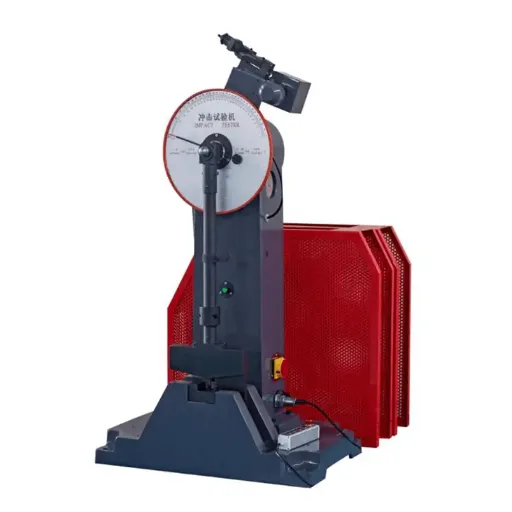
How Semi-Automatic Impact Testing Machines Work
Semi-automatic impact testing machines serve a critical function by determining how well a material can endure a sudden, sharp impact. Like manual impact testers, these machines use a pendulum or hammer to impart a set amount of energy onto a prepared specimen. However, the energy imparted is precisely measured and controlled. The impact data gives insight into the material’s toughness, durability, and energy absorption capacity before fracturing, allowing one to characterize and even predict the material’s behaviour in practical applications.
The impact process begins with fitting the test specimen into the machine, and the impact marks the falling of the pendulum or hammer onto the specimen with a set predetermined energy. Post-impact, measurements, including the energy absorbed by the specimen, are recorded for further analysis to determine material attributes such as brittleness or impact resistance. The lower amount of human interference is one of the hallmark features of these machines, as it improves the accuracy of the results and significantly cuts down on operator supervision.
The materials testing industry is a prime user of such equipment, especially in product development and quality assurance. In comparison with fully manual testing, quality assurance checks using semi-automated equipment require less time and are more precise. Their consistent functionality guarantees that proper, dependable testing is conducted to select materials, especially when choosing materials for construction, automotive, aerospace, and numerous other industries. Semi-automated impact testing machines offer a much-needed advantage in the pursuit of engineering safety and ingenuity.
Key Features of Semi-Automatic Impact Testers
Efficiency is the name of the game with semi-automatic impact testers. Like other testers, they deliver accurate results, but what makes them truly stand out is the ability to conduct impact tests repeatedly and consistently with minimal variation—remember, the human hand always has some tremor. This is especially useful as the results can be used for tests such as material selection and other safety-critical tests. They are also equipped with automated mechanisms that take care of specimen alignment, making the entire testing procedure smooth and precise.
Semi-automatic impact testers come with other important functionality: ease of use. Generally, operators can use a digital control panel or simple software to quickly configure test parameters and access test outputs. Such ease of use means that operators do not need to be specially trained; they can spend more time interpreting results from the device than struggling with the device itself. In addition, safety features like shields and automated specimen holders, which are designed to safeguard the operator, are often standard with these models.
Last but not least, semi-automatic impact testing equipment demonstrates strong maintainability and flexible use. The materials, including metals and polymers, they are designed to work with can be tested under stiff procedures. The versatile design enables compliance with testing from different industries like construction, automotive, and aerospace, which makes semi-automatic impact testers crucial in quality assurance and R&D innovation.
Comparison with Fully Automatic and Manual Testing Machines
| Machine Type | Functionality | Cost | Best For |
|---|---|---|---|
| Manual | Basic functionality, full operator control | Lowest | Limited budget, basic testing |
| Semi-Automatic | Partial automation, operator autonomy | Moderate | Balanced accuracy and control |
| Fully Automatic | Advanced technology, minimal human interaction | Highest | Mass production, high standardization |
The comparison between fully automatic, semi-automatic, and manual impact testing machines reveals distinct differences in functionality, performance, and expense. Semi-automatic devices provide a middle ground. Unlike fully manual machines, which offer basic functionality, and fully automated systems, which come with advanced technology, semi-automatic machines enable partial automation. This helps in minimizing errors and enhancing consistency, allowing the operator to exercise some level of autonomy during the test. Such features serve well in industries and laboratories that demand a high degree of accuracy but without the need for full automation.
In contrast, fully automatic impact testing machines require virtually no human interaction during functioning. For example, in mass production, where tempo and standardization are of the essence, as in mass production. However, they tend to be more expensive initially, and arguably, they and their upkeep are more complex. Along with that, for smaller businesses and for industries with infrequent needs for testing, their advanced machinery might be of no use.
Manual testing machines represent the most simple and least costly type. They demand full attention and operation from the user, making them ideal for rudimentary testing or in cases where funds are limited. The risk of mistakes on the part of the operator is much greater as well as the lack of repeatability and the time taken. Thus, they are inappropriate for strict or large scale testing. In the end, the appropriate type of machine is determined by the exact business functions, the level of detail that needs to be achieved, and the funds available.
Benefits of Using Semi-Automatic Impact Testing Machines

Key Advantages
- ✓ Improved Efficiency: Reduced testing time through automation
- ✓ Enhanced Accuracy: Minimized human error and variability
- ✓ Cost-Effective: Balance between functionality and investment
- ✓ Consistent Results: Reliable and reproducible testing outcomes
Improved Efficiency and Accuracy
Compared to completely manual systems, semi-automatic impact testing machines offer noteworthy advantages in effectiveness and precision. These advanced machines reduce testing time by automating vital phases of the testing procedure. This boosts efficiency, thereby increasing overall output for places where a large number of tests are done in a limited time.
Compared to fully manual systems, semi-automatic impact testing machines provide better effectiveness and precision. They reduce human participation in measurement and operation, which helps reduce the chance of mistakes. As a consequence, the impact testing machines can provide better and consistent results. This level of consistency is necessary in maintaining the dependability of the test results, especially in sectors where accurate information is needed.
In addition, impact testing machines that are semi-automatic require less training and have simplified controls, making it easier for operators to handle them. They do not have the limitations of manual machines, nor are they fully automated, allowing to save on cost while still providing the impact testing devices with some vital features of the fully automated machines. Therefore, they fit the small and medium scale testing where the impact testing devices require improved efficiency, accuracy and are user friendly.
Consistency in Testing Results
Uniformity is necessary in impact testing, for the tests to be reliable and reproducible. In impact testing, when test methods yield uniform results, operators can derive meaningful inferences and take correct actions in relation to a material’s properties. Such dependability is vital in industries like manufacturing, construction, and material science, where safety and functionality hinge on accurate test results. The impact of semi-automated testing machines on maintaining such uniformity cannot be overstated.
By controlling and conducting force application within specified testing conditions, these machines reduce the chance of human error to a great extent. As a result, the variability that stems from manual testing is greatly diminished. Such characteristics make semi-automated testing machines a perfect fit for industries that operate under strict quality compliance.
Moreover, uniform test results facilitate enhanced quality assurance and cross-batch evaluations. Consistent testing data enable organizations to certify materials with confidence, refine operational processes, and comply with industry regulations. Therefore, focusing on the consistency of testing results supports operational effectiveness while fostering confidence in the accuracy and authenticity of the data. Achieving these goals in small to medium-sized testing environments is made easier with the use of semi-automated machines.
Cost-Effectiveness for Laboratories
The purchase of a specialized impact testing machine would serve to enhance your laboratory operations from a cost-benefit perspective. Such machines would, with automation, complete processes of the testing procedures which would reduce manual testing. The improvement of workflows and increased throughput would lead to an increase in the number of operations that could be completed in a set period. This would lead to a decrease in operational testing costs and would make resource allocation more efficient.
Impact testing machines, on the other hand, improve precision and consistency in testing which would lead to less material waste. The testing machines would provide accurate and reliable results, significantly reducing testing and error chances. Impact testing machines are a valuable laboratory asset because the efficiency obtained, and the cost savings, would greatly surpass the amount spent in purchasing the machines.
To conclude, having impact testing machines would allow laboratories to be fully compliant with testing standards, which would significantly reduce the risk of getting fined or engaging in tests that may have legal repercussions. With their automated testing machinery features, impact testing machines guarantee standardized testing, which would improve the reputation of the laboratories due to the verified data obtained. All these features—efficiency, accuracy, and compliance—enable impact testing machines to provide a cost-effective solution in today’s testing laboratories.
Choosing the Right Semi-Automatic Impact Testing Machine

Factors to Consider: Material Type and Testing Standards
While purchasing a semi-automatic impact testing machine, understanding the type of material being tested for is crucial. Different test materials require different setups so that testing is done accurately. For metals, higher impact forces are generally required, while plastics require testing at a relatively lower range of energy so that the machine does not get overloaded. Answering these questions regarding the properties of the material helps a tester in choosing a machine that is best for his/her requirements of the particular testing process.
Another salient factor to consider is the compliance of the machine with testing standards. Usually, it should follow accepted standards such as are ASTM, ISO, or EN guidelines, which form the basic procedures for doing reliable impact tests. These standards guarantee consistency and accuracy, making it possible to compare results reported by different laboratories. Machines to which such standards apply have the advantage that proof of compliance is offered as well, thereby providing assurance about quality and repeatability.
Lastly, think of testing parameters supported by the machine, such as temperature controls, energy capacity, safety features, and so on. For some materials, it may be necessary to put the testing apparatus through extreme conditions to verify the cases of real-world applications. Selecting a good az machine for adaptable features gives more room for adaptability and further applications. By paying attention to these parameters, laboratories can be assured of buying into an investment that is reliable and cost-efficient for their testing requirements, both in the near term and long term.
Operational Demands and Equipment Specifications
Impact testing machines play a pertinent role in analyzing the resistance and behavior of the material subjected to test by sudden force or stress. For operational requirements, these machines should provide precision, durability, and repeatable results on the testing of various conditions. They are needed to find out impact strength and fracture behavior of materials, which are important in automotive, construction, and manufacturing fields.
An impact testing machine varies with regard to spec requirements depending on the corresponding type of test. Machines capable of counterchecking various impact energies, executions of various test configu-rations such as Charpy and Izod for different materials and standards of testing, plus functionality with fastening of the pendulum to change the distance fallen or giving the result to a digital display to read by the operator, give ease of use and maybe more accurate. For future needs, testing needs are taken into consideration by laboratories for machines that will work in the present.
The suitability of a machine is subjected to ease of maintainance and operation safety accorded by international testing standards beyond its technical capability. An impact testing machine with reliability shortens the downtime and guarantees the time-longed service, making it one worthy of elective consideration for laboratories that are efficiency and cost-conscious. Factoring all these in allows labs to procure machinery that will cater to their needs for optimizing operation in the long run.
Supplier Considerations and Recommendations
The importance of reliability and industry compliance must be placed on when selecting a supplier for impact testing machines. Pick only those suppliers who honor recognized international standards for testing equipment. This way, the machines become paramount to making judgments —accurate with consistent results-for the outcome of the processes that will undergo testing. In contrast, suppliers who are known for tested and proven machinery shall be taken up during evaluation.
Further, take into consideration the field service and customer support offered by the supplier. Ideally, the supplier will offer full after-sales services such as preventive and scheduled maintenance, repair services, and provision of spare parts on demand. Less downtime for maintenance or repair gives longer use of the equipment. Go through their warranty and service agreements so that they fit in well with the laboratory’s operation and budgetary requirements.
At last, the ability of the supplier should be checked for providing tailor-made solutions or perhaps training to the user. Labs often work with very unique testing requirements, so if the supplier does some customization to the machine or especially gives some training, it could help streamline the operations and the safety as well. By asking for some case studies or references from other teenage laboratory customers, you will be able to determine satisfaction and performance reliability. Selection upon these considerations will just give you the right supplier for your impact testing machine.
Recent Advancements in Impact Testing Technology

Integration of Smart Features and Automation
Integration of smart features and automation into impact testing machines has, in turn, created a revolution in the field as it aids in precision, efficiency, and ease of operations. Today, impact testing machines incorporate sensors and microprocessor controls for acquiring and analyzing data in real-time, with the result that test data accuracy because of human interpretation and mistakes is drastically diminished. Now operators can also watch the testing remotely; hence, testing can be implemented, resulting in uniformity and reliability of results.
Automation in impact testing systems is a streamlining operation. This requires very little manual intervention.Automated handling and testing of specimens save time, more so when high-volume testing is involved. Having fewer human interventions reduces errors and creates a uniform testing process vital to consistent performance and material quality assessments through several tests. Moreover, these automated features are developed with operator safety in mind, especially during hazardous procedures.
User-friendly software interfaces are another term for noteworthy advances. These interfaces are designed to be simple and easy to work with so that operators can readily configure test parameters and analyze data. Custom reporting features, meanwhile, provide detailed analysis and insight tailored to specific requirements. By marrying these innovations, today`s impact testers attain acceptance in the industry, reproducible results, and high-quality outcomes aligned with recent technology advancement.
Data Analytics in Impact Testing
Impact testing machines are an entirely crucial set of tools utilized for assessing the toughness and structure of materials under sudden loads. By analyzing this test, a material-chosen parameter, such as energy absorption during fracture, can be identified; this is essentially of help in assessing real-life performance of the material. Hence, the whole process aids engineers and manufacturers in certifying that the material adheres to safety requirements and performs satisfactorily under imposed stresses.
Meaningful data analytics significantly contribute toward ultimately improving accuracy and fulfilling the aim of the impact testing. From the array of data accumulated and analyzed at different instances when tests are conducted, an operator might spot patterns and trends not discernible to the naked eye. Hence, the weaknesses can be identified; one can predict material performance and contribute toward better design optimization. At the same time, newer visualization techniques comparatively ease result interpretation and provide some useful implications for the process, thereby offering better reliability and usability to the whole testing procedure.
By involving data analytics into impact testing machines, one ensures that the exercise facilitates quality control and product development with a higher degree of accuracy. This decision-making occurs by manufacturers who rely on evidence from laboratory results to ascertain the validity or otherwise of their decision. This saves both material and time and encourages the development of new materials competing with the modern-day industries. Such technologies furnish industries with safer, more efficient, and innovative solutions for all of their applications, in sectors as diverse as automobiles, construction, and aerospace.
Future Trends in Impact Testing Equipment
With technological advances, impact testing machines also are getting more innovative to meet the requirements for more precise, quicker, and multipurpose testing options. A key feature of the trend is digital integration, with sensors and computers increasingly embedded within machines to gather data in real time and analyze it. In doing so, this provides manufacturers with a more accurate means of testing materials for impact resistance, while also assisting in testing efficiency.
The other significant trend lies in the development of environmentally friendly impact testing. Eco-friendly solutions put a green emphasis on equipment that consumes less energy during testing and in doing so also wastes relatively little. Compact designs are becoming more popular and offer the possibility of conducting testing outside the orthodox testing environments or laboratories. The value of these is even higher for on-site applications such as construction and remote manufacturing facilities.
Besides, developing and testing more advance
Frequently Asked Questions (FAQ)
Q: How is the Charpy test performed?
A: The notched specimen is hit by the pendulum at a specified height in this test. The energy imparted to the specimen as it fractures is measured. This data is critical in determining a material’s toughness and resistance to impact.
Q: What are the advantages of using the semi-automatic impact testing machine?
A: These semi-automatic impact testing machines feature efficient operation with improved accuracy and reliability. Compared to their fully automatic counterparts, they experience less manual interference and are, therefore, suitable for laboratories that accommodate both efficiency and some hands-on control.
Q: What kind of materials can be tested by means of a semi-automatic impact testing machine?
A: A semi-automatic impact testing machine tests various metal materials, such as steel and alloys, for their resistance to impact and behavior under dynamic loading.
Q: Is it possible to operate by automatic control a charpy impact testing machine?
A: Yes, some charpy impact testing machines are computer-controlled and thereby can increase the precision of the testing procedure. This technology allows certain stages of the impact test to be automated, and ensures a more reproducible result.
Q: What is the use of a control box in a semi-automatic impact testing machine?
A: In a semi-automatic impact testing machine, the operators handle the controls of the testing device in order to set parameters for a given test, observe the data in real-time, and ensure the accuracy of the tests during all stages.
Q: How does pendulum impact testing differ from any other impact testing method?
A: The pendulum impact test involves the impact of a certain force through a swinging pendulum. This particular method can best simulate real dynamic loads and measure energy absorption when the material yields.
Q: Why is it important to know the anti-impact ability of metallic materials?
A: The determination of the anti-impact ability of metallic materials in industries like construction and automobile is essential because materials must resist sudden loads and impacts without failing. This helps in choosing the right material for a particular application.
Q: In what way does the jb-b series of semi-automatic impact testing machines improve efficiency in testing?
A: The jb-b series of semi-automatic impact testing machines enhance efficiency by incorporating various advanced features such as sample loading and retrieval automation, along with motion control devices, all of which yield much shorter turnaround times while still providing greater accuracy in impact test results.
Frequently Asked Questions (FAQ)
-
Semi Automatic Impact Tester – Munro Instruments
Provides details about a semi-automatic impact tester and its features. -
300J Semi-Automatic Charpy Impact Test Machine – UTM China
Focuses on the JBW-B computer-controlled semi-automatic Charpy impact testing machine. -
Impact Testing Machine Series from China Manufacturers – ASTM Testing Equipment Co., Ltd.
Explores a range of impact testing machines, including semi-automatic models.

